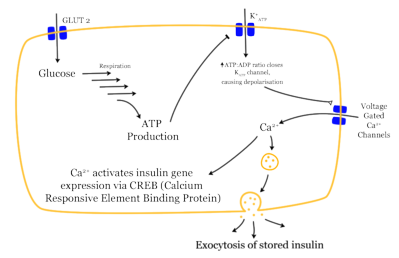Diabetes, insulin dependent
Diabetes mellitus is a medical disorder characterized by varying or persistent hyperglycemia (elevated blood sugar levels), especially after eating. All types of diabetes mellitus share similar symptoms and complications at advanced stages. Hyperglycemia itself can lead to dehydration and ketoacidosis. Longer-term complications include cardiovascular disease (doubled risk), chronic renal failure (it is the main cause for dialysis), retinal damage which can lead to blindness, nerve damage which can lead to erectile dysfunction (impotence), gangrene with risk of amputation of toes, feet, and even legs. more...
The more serious complications are more common in people who have a difficult time controlling their blood sugars with medications (glycemic control).
The most important forms of diabetes are due to decreased or the complete absence of the production of insulin (type 1 diabetes), or decreased sensitivity of body tissues to insulin (type 2 diabetes, the more common form). The former requires insulin injections for survival; the latter is generally managed with diet, weight reduction and exercise in about 20% of cases, though the majority require these strategies plus oral medication (insulin is used if the tablets are ineffective).
Patient understanding and participation is vital as blood glucose levels change continuously. Treatments which return the blood sugar to normal levels can reduce or prevent development of the complications of diabetes. Other health problems that accelerate the damaging effects of diabetes are smoking, elevated cholesterol levels, obesity, high blood pressure, and lack of regular exercise.
History
Although diabetes has been recognized since antiquity, and treatments were known since the Middle Ages, the elucidation of the pathogenesis of diabetes occurred mainly in the 20th century6.
Until 1921, when insulin was first discovered and made clinically available, a clinical diagnosis of what we now call type 1 diabetes was an invariable death sentence, more or less quickly. Non-progressing type 2 diabetics almost certainly often went undiagnosed then; many still do.
The discovery of the role of the pancreas in diabetes is generally credited to Joseph Von Mering and Oskar Minkowski, two European researchers who, in 1889, found that when they completely removed the pancreas of dogs, the dogs developed all the signs and symptoms of diabetes and died shortly afterward. In 1910, Sir Edward Albert Sharpey-Schafer of Edinburgh in Scotland suggested diabetics were deficient in a single chemical that was normally produced by the pancreas - he proposed calling this substance insulin.
The endocrine role of the pancreas in metabolism, and indeed the existence of insulin, was not fully clarified until 1921, when Sir Frederick Grant Banting and Charles Herbert Best repeated the work of Von Mering and Minkowski but went a step further and managed to show that they could reverse the induced diabetes in dogs by giving them an extract from the pancreatic islets of Langerhans of healthy dogs7. They went on to isolate the hormone insulin from bovine pancreases at the University of Toronto in Canada.
This led to the availability of an effective treatment - insulin injections - and the first clinical patient was treated in 1922. For this, Banting et al received the Nobel Prize in Physiology or Medicine in 1923. The two researchers made the patent available and did not attempt to control commercial production. Insulin production and therapy rapidly spread around the world, largely as a result of their decision.
Read more at Wikipedia.org



